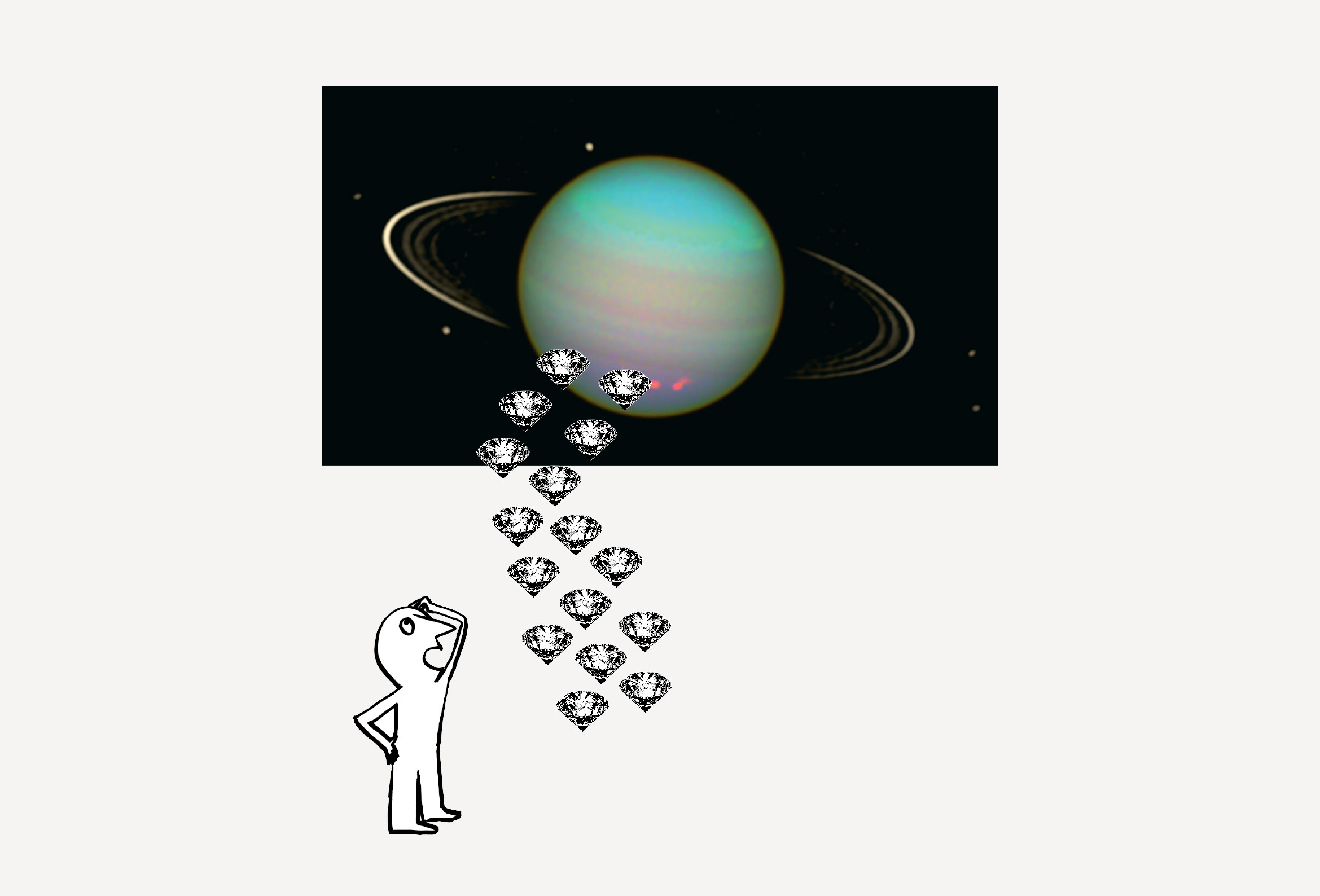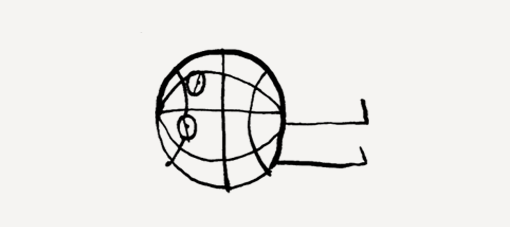
Do you know how to get to a place where cosmic rain falls from the skies? You have to climb the ladder of abstraction.
There are, of course, many reasons to love the world and the science that describes it so beautifully. One of these is the phenomenon called ‘universality’. This educated term in fact represents a simple concept: that ‘the same’ can happen in various incarnations, and that different actors can play out the same scenario. The search for hidden similarities in different events is a favourite pastime for the human mind, seeking the general and the abstract. What else illustrates this better than snow?
The young guys and the old man
Before we jump into the subject of sleet, let’s discuss the actual method. The key word for today is ‘abstraction’. Abstraction is fundamentally about losing the details in order to arrive at something general. My unrequited love for Marysia and Jacek’s for Basia are obviously two completely different stories. And, sitting with Jacek over a beer, I will wait impatiently for my turn to confess; because what has Jacek’s problem got to do with mine? True? But an old man, sipping his Jägermeister, barks to the barman about how many times he’s heard such stories from dozens of young bucks. And that time is the best medicine. The old man isn’t interested in the fact that Marysia isn’t Basia and that I am not Jacek. He abstracts from these details, moving away from two, specific, broken hearts to reach the abstract concept of ‘unrequited love’.
Abstraction is a dangerous and difficult game. Blasé old men can take this to absurd levels. Now Krzysiek enters the bar and is sad because his holiday has just ended and he is already pining for his lakeside vacation. A completely different problem but, as he tucks into his next Jägermeister, the old boy chuckles, “these youngsters always want what they can’t have; they want girls, that one, this holiday… Humility, you all need some humility!” And this is abstraction at the edge of reason. Here we see how a new category of understanding called ‘wanting something that one cannot have’, developed by some wise guy in the pub, starts to encompass an increasing range of contexts from which one must remove more and more details in order to make them fit his model.
Let’s just add that the end point of the abstraction process is generally metaphysical categories such as Aristotle’s ‘substance’. But today we will not go that far. Today, as we play with abstraction, I will endeavour to convince you, Dear Readers, that everything is snow.
Take an umbrella, it’s raining methane
Let’s begin with the precipitation we know best; rain and snow. What in actual fact is it? Our chosen meteorologist will patiently explain (if, of course, it’s not dripping down his neck) that a certain amount of water is dissolved in the air in the form of water vapour. If the damp air cools enough, the water vapour precipitates (or condenses) in the form of droplets or, if it is even colder, ice crystals. One can cause such condensation locally too, for example by placing a cold drink in a glass on a table. Water droplets will start to form on the glass. However, on an atmospheric scale, this results in the formation of – warning: technical term from atmospheric physics – clouds.
The droplets in the clouds may be too small for the force of gravity to pull them downwards. However, when they reach a certain critical mass, they start to be dragged to the base of the cloud. This process is self-generating, because each droplet that tumbles down pulls other, smaller ones with it, growing as it goes. In time, a whole streak of droplets forms, heading for the ground. If, on the way, it is blown away or evaporates, one gets a ‘virga’. You will certainly have noticed this view – a delicate streak beneath a layer of cloud, which looks like someone gently stirred it with their finger. When the droplets make it to the outer surface of the cloud, this is already rain. The rest of the story you also know. If the temperature is cold enough, crystals, not droplets, form in the cloud, and their slow fall in the first phase causes them to grow, resulting in snowflakes. When there is high humidity and there are powerful upward gusts of air, the crystals grow fast, creating hail.
Placing rain, snow and hail into a single category called ‘precipitation’ is our first level of abstraction. This general term covers anything that precipitates (condenses) from dissolved water vapour and subsequently ends up falling to Earth. In the age of cosmic discovery, an obvious extension is the second level of abstraction: using the same name for what also happens in other atmospheres within the Solar System. Because of the different chemical composition of these atmospheres, the names for these types of precipitation sound rather exotic to the earthly ear. The methane rains on Titan are famous; falling from methane clouds, creating methane rivers that flow into methane lakes. Fans of astronomy will surely also have heard about the rather unpleasant-sounding sulphuric acid rain on Venus, although technically this is a ‘virga’, because the stream of hot acid evaporates before it reaches the surface of the planet. And… basically that’s it. In a few places in the Solar System, for example on Mars, we also find versions of haw frost, i.e. examples of something forming from the atmosphere directly on the surface without falling. But for real precipitation one needs a solid, thick atmosphere. And it appears that we only have three of these to hand: Venus, Earth and Titan.
Fans of cosmic precipitation, however, can go further; for aren’t the enormous outer planets not also wrapped in gigantic gas blankets? At this point we move to the third level of abstraction. For in as much as the outer atmospheric layers of Jupiter, Saturn, Uranus and Neptune have, in reality, a relatively normal atmosphere, with every successive kilometre into their gigantic bodies, their atmospheric matter has less and less in common with gas. From a certain depth, and not that deep, under monstrous pressure, their atmospheres become a particular type of thick, stiff liquid; a fantastic conductor of electricity, which looks more like aspic jelly than air. Can it even ‘rain’ in such conditions?
Judge for yourselves. Let’s take the example of Jupiter. At a depth of about 15,000 kilometres (which exceeds the size of Earth but, in the case of this giant, is only one quarter of the way to the core), the atmosphere of the planet, comprised almost exclusively of hydrogen and helium, has the density of water and a temperature of 5-10,000 degrees Celsius. This already ought to make us realize how far the conditions there are beyond our understanding. On Earth, hydrogen and helium are simply gases and, after heating them to several thousand degrees, they become nothing more than… hot gases. In Jupiter’s overcoat, however, under the massive pressure from the atmosphere above, hydrogen and helium are more liquid than gas, even though the temperature is higher than on the surface of the Sun. Even stranger, in such a high temperature, electrons escape their nucleus and create their own, separate ‘electron liquid’ which means, in practice, that this hydrogen-helium stew is something akin to liquid metal. But let’s return to precipitation, because we didn’t dive into this gas giant only out of natural curiosity. So, at that rough depth, a second component of the hydrogen-helium mixture emerges, falling towards the centre of the planet in the form of something that is described as helium rain. Scientists who model the interior of the giant planets sometimes even talk of ‘helium clouds’ in which helium droplets form slowly; one researcher, on a flight of fancy, even toyed with the notion ‘helium snowflakes’. Hmm. So, in the end, is it ‘rain’ or ‘snow’?
Well, basically the question is framed wrongly. The words ‘rain’ and ‘snow’ rely upon distinguishing water in its liquid form from its solid form, and there is no obvious way of ‘translating’ this for a world where ‘air’ is a metallic hydrogen at the temperature of the Sun. As we move up the ladder of abstraction, old terminology can be a burden until at a certain point it does more harm than good. And this is just the beginning.
Even more problematic are the ‘rains’ that fall on Uranus and Neptune, where massive balls, made of water, methane and ammonia, shelter under their hydrogen-helium overcoat. Well, the inadequacy of everyday language is best illustrated by the term ‘ice planets’, typically applied to them. Across the length and breadth of Uranus, one won’t find, in it or on it, so much as a gram of anything that could sensibly be described as ‘ice’. Of course, dozens of cold balls, flying about in the outer Solar System, such as the numerous satellites of Uranus or Pluto, have frozen, grey-white, solid substances on their surfaces, made of water, methane and ammonia, which would certainly crumble under an astronaut’s boot and from which one could, with a little imagination, build a snowman. And indeed, under the thick hydrogen-helium blanket around Uranus and Neptune, there is a large ball made of these ingredients. But in the conditions that prevail there, they cannot create ice. For how could one possibly name a thick, lava-hot, magnetized liquid ‘ice’?
It is in precisely these conditions that probably the most exotic of all the ‘rains’ in the Solar System appears. Just as from the bowels of Jupiter and Saturn the helium-hydrogen liquid rains helium, so the carbon-hydrogen-nitrogen liquid in the bowels of Uranus and Neptune rains carbon. But under such intense pressure, this carbon does not take the form of soot or graphite, but – hah! – diamond. So, if the physics models aren’t lying, at a certain depth into the interior of the ‘ice’ planets, it is snowing diamonds that eventually fall into a diamond ocean.
Towards the limits of the metaphor
Once we have agreed that we want to describe diamond and helium precipitation in the atmospheres of the giant planets as ‘rain’ or ‘snow’, we find ourselves in difficulties we can’t get out of: for are we to call every substance that precipitates from another substance ‘snow’? Some examples? Be my guest.
To start with, let’s look at magma. In the magma chambers of the Earth’s crust, we get the precipitation of mineral grains which, once they’ve fallen to the bottom of the chamber, create a special type of rock called cumulative rock. ‘Olivine rain’ or a ‘downpour of magnetite?’ Why not? But in this case, it would be more appropriate to use the term ‘snow’, because the crystals of these minerals as they travel through a magma chamber grow into beautiful, regular shapes, just like snowflakes. This process must have looked particularly magnificent at the birth of the planet, when its entire surface was still liquid, creating a global ocean of magma. Oh! What snowstorms must have raged there? And the bottom of that ocean was gradually covered with deepening [snow] drifts of… hmm… magma rocks.
Since we’ve galloped ahead, we can go for broke. Our entire Solar System formed from a giant gas cloud within which, over time, larger grains and stones condensed, falling in a storm of rocky shards under the force of gravity. It was from this snowstorm that the largest hailstones emerged – embryonic planets – the seeds of all the planets that formed later.
But if we take just one small step backwards and look at the formation of our Solar System from the perspective of our galaxy, the Milky Way, we will see powerful clouds of galactic gas – thin and jagged, torn by galactic winds – from which, only now and again, stars and their surrounding planetary waste precipitate. In the gigantic gas atmosphere of our galaxy even today this rain of stars is still falling, although their current rate of formation deserves to be described as a drizzle in comparison to the times described by astronomers (and I’m not making this up) as star storms, when the galaxy was roaring from this star fall.
To finish, it is worth adding that the emergence of structures from gas is really a general cosmological process. Not only do the planets emerge from protoplanetary gas clouds and stars from the gassy galactic medium, but over a suitably large timeframe of billions of years and millions of light years, the galaxies themselves emerge from rare cosmic gas, then spin like powerful flat snowballs towards a common centre of gravitational attraction. Therefore, cosmogenesis is simply nothing more than a gigantic snowstorm, right?
Everything is possible, but what for?
Let’s go back, maybe, to the beginning. This was meant to be about the limits of abstraction. It turns out that physics doesn’t differ significantly from everyday language when it comes to applying generalities to particulars. Well, contrary to appearances, the above-mentioned processes can be brought to the same plane of physics more easily than the domain of everyday language.
From his mathematical toolbox, a physicist can produce a little miracle called ‘description of one substance precipitating from another’, which can be used to describe all kinds of cases where localized nuggets appear from a continuous medium. This is the so-called theory of nucleation, and its basic job is to model rain and snow and, equally, the precipitation of crystals from magma. Scientists also think in metaphors and it is not uncommon to find the term ‘star nucleation’ in astronomical literature.
Oh yes! Physicists love taking mathematical abstracts and putting them to the test in the most bizarre places. Take the theory of percolation, which was initially created to describe how liquid flows through a porous medium such as sponge or soil. With time, it became a general mathematical tool, developing not only in the context of how liquid squeezes through rock fissures, but also in its own beauty. Today, with the help of this same theoretical framework, one can model the ‘flow’ of information on a social network, or traffic flow in a town.
For physics, the key question is whether there is anything constructive about these types of applications that could be equivalent to an old man giving all three men sitting next to him the same advice and, also bizarrely, good advice. Surprisingly often, the results of such a test are positive, which leads us in fact to a rather poetic conclusion. At a certain level, not just metaphorically but also mathematically, we human beings are really the same as liquid seeping through shattered rock or flakes of heavy snow falling gently to the ground. Think about that for a while during the next snowstorm.









